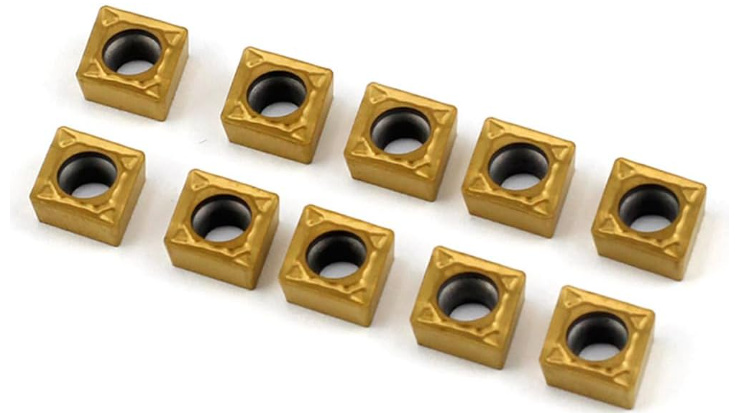정밀도와 효율성이 가장 중요한 가공 분야에서는 올바른 절삭 공구 재질을 선택하는 것이 모든 차이를 만들 수 있습니다. 다양한 옵션이 존재하지만, 카바이드 삽입 는 수많은 산업 분야에서 가공 프로세스를 혁신하며 명실상부한 챔피언으로 부상했습니다.
그렇다면 카바이드 인서트가 다른 절삭 공구 소재보다 우수한 이유는 무엇일까요? 이 블로그 게시물에서는 7가지 강력한 이점 카바이드 인서트를 현대 제조의 최전선으로 끌어올린 제품입니다.

1. 타의 추종을 불허하는 경도: 가장 까다로운 소재의 정복
주로 텅스텐 카바이드로 구성된 초경 인서트는 기존 공구강 및 고속강(HSS)을 훨씬 능가하는 뛰어난 경도를 자랑합니다. 이 놀라운 경도 덕분에 카바이드 인서트는 다음과 같은 다양한 소재를 손쉽게 가공할 수 있습니다:
- 강화 강철: 초경 인서트는 HSS 공구를 빠르게 무디게 하거나 손상시킬 수 있는 경화강을 처리하여 가공 가능성을 확장하고 내구성이 뛰어난 부품을 제작할 수 있습니다.
- 이국적인 합금: 항공우주 및 기타 고성능 산업은 중량 대비 강도가 뛰어난 이색 합금에 의존합니다. 카바이드 인서트는 이러한 까다로운 소재 가공에 탁월하여 항공우주, 의료 및 기타 까다로운 분야의 발전에 기여합니다.
- 연마재: 주철, 유리섬유, 탄소섬유 복합재와 같이 마모성이 강한 재료는 기존 절삭 공구를 빠르게 마모시킬 수 있습니다. 카바이드 인서트는 경도가 뛰어나 이러한 마모성 소재를 가공할 때에도 마모에 강하고 절삭 날을 오랫동안 유지합니다.
2. 탁월한 내마모성: 다운타임 최소화, 생산성 극대화
카바이드 인서트의 가장 중요한 장점 중 하나는 뛰어난 내마모성입니다. 다른 절삭 공구 재료에 비해 카바이드 인서트는 훨씬 더 오랜 기간 동안 날카로운 절삭 날을 유지합니다. 이는 곧
- 도구 변경 감소: 툴 교체 횟수가 줄어든다는 것은 가동 중단 시간이 줄어들고 기계 활용도가 높아져 생산성과 수익성에 직접적인 영향을 미친다는 것을 의미합니다.
- 툴링 비용 절감: 초경 인서트는 초기 비용이 높을 수 있지만, 수명이 길어 시간이 지남에 따라 전체 툴링 비용이 낮아지는 경우가 많습니다.
- 부품 일관성 향상: 일관된 공구 마모는 생산 공정 전반에 걸쳐 치수 정확도와 표면 마감의 일관성을 보장하여 불량률을 줄이고 전반적인 부품 품질을 개선합니다.
3. 고속 가공: 생산 가속화, 효율성 향상
초경 인서트는 고속 가공 작업 중 발생하는 극한의 온도와 힘을 견딜 수 있도록 설계되었습니다. 이를 통해
- 커팅 속도 향상: 초경 인서트는 HSS 공구보다 훨씬 빠른 절삭 속도로 작동하여 가공 시간을 획기적으로 단축하고 생산량을 높일 수 있습니다.
- 향상된 표면 마감: 더 빠른 절삭 속도와 초경 인서트의 고유한 특성을 결합하면 표면 마감이 더 매끄러워져 2차 마감 작업의 필요성을 줄이거나 없애는 경우가 많습니다.
- 향상된 칩 제어: 날카로운 절삭날과 최적화된 형상을 갖춘 초경 인서트는 효율적인 칩 형성 및 배출을 촉진하여 일관된 절삭 성능을 유지하고 공작물이나 공구를 손상시킬 수 있는 칩 축적을 방지하는 데 매우 중요합니다.
4. 다양한 활용성: 모든 작업을 위한 도구
초경 인서트는 매우 다재다능하며, 특정 가공 작업 및 재료에 맞는 다양한 재종, 형상 및 코팅으로 제공됩니다. 이처럼 광범위한 옵션 덕분에 거의 모든 가공 작업에 완벽하게 적합한 초경 인서트가 있습니다:
- 선회: 황삭에서 정삭 작업에 이르기까지 초경 인서트는 외경과 내경을 선삭하고 홈을 만들고 부품을 분리하는 데 탁월한 성능을 발휘합니다.
- 밀링: 초경 인서트는 밀링 응용 분야에서 널리 사용되며, 페이스 밀링, 숄더 밀링 및 슬롯 밀링 작업에서 재료를 효율적으로 제거합니다.
- 드릴링: 카바이드 팁 드릴은 특히 단단한 재료를 드릴링하거나 고정밀 구멍이 필요한 드릴링 작업에서 탁월한 성능을 발휘합니다.
- 지루합니다: 초경 인서트는 보링 공구에도 사용되어 정밀한 내경과 매끄러운 보어 마감을 구현할 수 있습니다.
5. 향상된 정밀도와 정확성: 엄격한 허용 오차 요구 사항 충족
현대 제조업은 특히 항공우주, 의료, 전자 등의 산업에서 매우 엄격한 공차를 요구하는 경우가 많습니다. 카바이드 인서트는 날카로운 절삭 날을 유지하고 높은 절삭력에서도 휨에 저항하는 능력을 갖추고 있어 이러한 엄격한 요구 사항을 충족하는 데 탁월합니다:
- 복잡한 지오메트리: 초경 인서트는 복잡한 모양과 특징을 뛰어난 정확도로 제작할 수 있어 복잡한 디자인이나 엄격한 공차 요구 사항이 있는 부품에 필수적입니다.
- 진동 감소: 카바이드 인서트의 고유한 강성은 가공 중 진동을 최소화하여 표면 마감을 개선하고 치수 정확도를 높입니다.
- 미세한 표면 마감: 카바이드 인서트는 매우 미세한 표면 마감을 구현할 수 있어 연마나 연마와 같은 2차 마감 작업이 필요 없는 경우가 많습니다.
6. 장기적인 비용 효율성: 투자 수익 극대화
초경 인서트는 일부 기존 도구 재료에 비해 초기 비용이 높을 수 있지만, 장기적인 비용 효율성은 부인할 수 없습니다.
이러한 요소를 고려하세요:
- 연장된 도구 수명: 초경 인서트는 HSS 공구보다 훨씬 오래 사용할 수 있어 공구 교체 빈도를 줄이고 전체 툴링 비용을 낮춥니다.
- 생산성 향상: 더 빠른 절삭 속도와 공구 교체로 인한 가동 중단 시간 감소는 생산량 증가로 이어져 투자 수익을 극대화합니다.
- 부품 품질 향상: 일관된 공구 마모와 향상된 정밀도로 고품질의 부품을 생산하여 불량률을 줄이고 재료 낭비를 최소화합니다.
7. 고급 가공 기술과의 호환성
카바이드 인서트는 다양한 고급 가공 기술과 호환되므로 기능이 더욱 향상되고 응용 분야가 확장됩니다:
- CNC 가공: 초경 인서트는 정밀도와 반복성이 가장 중요한 컴퓨터 수치 제어(CNC) 머시닝 센터에 사용하기에 이상적입니다.
- 고압 냉각수 시스템: 카바이드 인서트와 함께 고압 절삭유 시스템을 사용하면 특히 까다로운 가공 작업에서 칩 배출을 최적화하고 열 방출을 개선하며 공구 수명을 연장할 수 있습니다.
- 건식 가공: 일부 초경 인서트 재종은 건식 가공용으로 특별히 설계되어 절삭유가 필요 없고 환경 친화적인 제조 공정을 촉진합니다.
카바이드 인서트와 다른 절삭 공구 재질의 비교: 비교 살펴보기
| 재질 | 경도 | 내마모성 | 절단 속도 | 비용 | 장점 | 단점 |
|---|---|---|---|---|---|---|
| 초경 인서트 | 매우 높음 | 우수 | 높음 | 높음 | 탁월한 경도, 내마모성, 고속 성능, 다용도성, 정밀성 | 더 높은 초기 비용 |
| 고속 강철(HSS) | 높음 | 양호 | 보통 | 보통 | 다양한 소재에 적합한 전반적인 특성 균형이 우수합니다. | 카바이드 인서트에 비해 낮은 경도 및 내마모성 |
| 코발트 스틸 | 매우 높음 | 매우 좋음 | 보통 | 높음 | 내열성이 뛰어나 고온 애플리케이션에 적합 | HSS보다 비싸고 카바이드 인서트보다 경도가 낮습니다. |
| 도자기 | 매우 높음 | 우수 | 매우 높음 | 매우 높음 | 뛰어난 경도, 내마모성 및 고속 성능으로 매우 단단한 재료에 적합합니다. | 부서지기 쉽고 깨지거나 파손되기 쉬움 |
결론 결론: 카바이드의 이점 수용하기
다른 절삭 공구 재료에 비해 카바이드 인서트의 장점은 부인할 수 없습니다. 뛰어난 경도, 내마모성, 고속 성능, 다용도성 및 정밀성은 가공 공정에 혁명을 일으켜 다양한 산업 분야에서 더 높은 품질, 더 복잡하고 더 저렴한 제품을 만들 수 있게 해줍니다.
기술이 계속 발전하고 제조 요구 사항이 점점 더 엄격해짐에 따라 초경 인서트는 의심할 여지 없이 절삭 공구 기술의 선두에 서서 혁신을 주도하고 제조의 미래를 만들어 나갈 것입니다.
우수한 품질의 카바이드 인서트를 합리적인 가격에 구매하고 싶으신가요? 클릭 여기.




